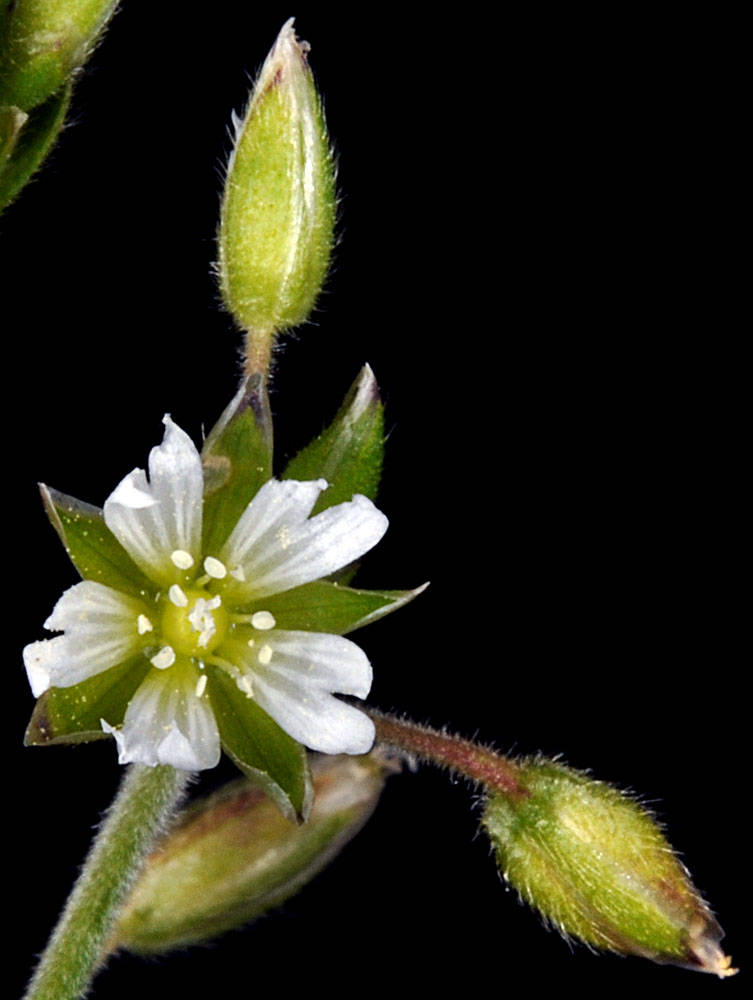
Plants perennial, often flowering in first year (appearing as an annual).
Stems 6–45 cm; non-flowering stems mat-forming; flowering stems erect, hairs usually not glandular, rarely glandular.
Leaves lanceolate to oblong, 8–25 mm; axillary leaves absent.
Inflorescences open cymes; uppermost bract margins white, scarious; pedicels in fruit 1–4 × length of sepals.
Flowers sepals 4.5–7 mm, hairs non-glandular or sometimes glandular, not extending beyond sepal tip; petals deeply 2-lobed, 4–5 mm, (0.6)1 × length of sepals; stamens 10.
Fruits curved, (6.5)8–13 mm.
Seeds 0.6–0.9 mm.
2n=126, 136, 144.
Disturbed areas, yards, beaches, wet meadows, open woods. Flowering Mar–Aug. 0–2600 m. All ecoregions. CA, ID, NV, WA; nearly worldwide. Exotic.
Cerastium fontanum and C. glomeratum, long known as C. vulgatum and C. viscosum respectively, are the most common and widely distributed of the introduced Cerastium species. Both have at some time been confused with each other and other members of the genus. A few specimens have been seen from Oregon that exhibit a brownish hirsute pubescence on the stems and pedicels and bracts with very narrow scarious margins; the flowers match C. fontanum.
as described under Cerastium fontanum ssp. vulgare
Plants perennial (very rarely annual). Inflorescences usually eglandular, occasionally viscid and glandular. Petals equaling sepals. Capsules 9-13 mm. Seeds 0.4-0.9 mm; tubercles small. 2n = ca. 122-152, usually 144.Flowering throughout growing season. A common weed in grassy places: lawns, roadsides, pastures, open woodlands, wastelands; 0-3000 m; introduced; Greenland; St. Pierre and Miquelon; Alta., B.C., Man., N.B., Nfld. and Labr., N.W.T., N.S., Ont., P.E.I., Que., Sask., Yukon; Ala., Alaska, Ariz., Ark., Calif., Colo., Conn., Del., D.C., Fla., Ga., Idaho, Ill., Ind., Iowa, Kans., Ky., La., Maine, Md., Mass., Mich., Minn., Miss., Mo., Mont., Nebr., Nev., N.H., N.J., N.Mex., N.Y., N.C., N.Dak., Ohio, Okla., Oreg., Pa., R.I., S.C., S.Dak., Tenn., Tex., Utah, Vt., Va., Wash., W.Va., Wis., Wyo.; Europe; introduced worldwide.Small annual forms of subsp. vulgare can be difficult to separate from Cerastium pumilum. The latter has smaller capsules, narrower and sharply acute sepals, and short, glandular hairs on the sepals, bracts, and inflorescence.